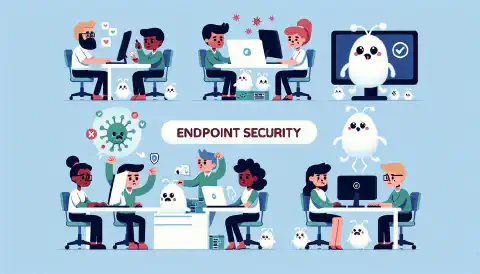Securing Cloud Excellence: Unleashing the Power of CSPM for Business Resilience

Table of Contents
Leveraging Cloud Security Posture Management (CSPM) for Your Business
Cloud Security Posture Management (CSPM) is a vital aspect of ensuring the security and compliance of your business’s cloud infrastructure. By leveraging CSPM solutions, organizations can gain enhanced visibility and control over their cloud security, proactively detect and remediate threats, and ensure compliance with industry regulations and standards. However, implementing CSPM comes with its own set of challenges and considerations, such as addressing scalability and complexity, managing false positives and alert fatigue, and finding the right balance between automation and human oversight. To effectively implement CSPM, it is important to establish clear security policies and procedures, regularly monitor and audit cloud environments, and collaborate with cross-functional teams for holistic security. Here are the key takeaways from this article:
Key Takeaways
- CSPM provides enhanced visibility and control over cloud security
- Proactive threat detection and remediation are key benefits of CSPM
- CSPM helps ensure compliance with industry regulations and standards
- Address scalability and complexity when adopting CSPM
- Find the right balance between automation and human oversight in CSPM implementation
Understanding Cloud Security Posture Management (CSPM)
What is CSPM?
Cloud Security Posture Management (CSPM) is a comprehensive approach to ensuring the security and compliance of cloud environments . It involves continuously monitoring and assessing the security posture of cloud resources, identifying misconfigurations, vulnerabilities, and threats, and providing recommendations for remediation. CSPM solutions leverage automation and machine learning to streamline the process and enable organizations to proactively manage their cloud security.
Why is CSPM important for businesses?
CSPM plays a crucial role in ensuring the security of cloud environments for businesses. With the increasing adoption of cloud services and the growing complexity of cloud infrastructures, it is essential for organizations to have a comprehensive understanding of their cloud security posture. CSPM provides businesses with the necessary tools and capabilities to assess, monitor, and manage their cloud security effectively.
Key features of CSPM solutions
Cloud Security Posture Management (CSPM) solutions offer a range of key features that help businesses enhance their cloud security. These features include:
- Continuous monitoring: CSPM solutions provide real-time monitoring of cloud environments, allowing businesses to detect and respond to security threats promptly.
- Automated compliance checks: CSPM solutions automate the process of checking cloud configurations against industry best practices and compliance standards, ensuring that businesses maintain a secure and compliant posture.
- Risk assessment and prioritization: CSPM solutions assess the risk level of various cloud assets and prioritize remediation efforts based on the severity of the risks.
- Policy enforcement: CSPM solutions enforce security policies and ensure that cloud resources are configured according to the organization’s security requirements.
By leveraging these key features, businesses can effectively manage their cloud security posture and mitigate potential risks.
Implementing CSPM in Your Business

Assessing your cloud security posture
Assessing your cloud security posture is a critical step in ensuring the overall security of your cloud environment . It involves evaluating the current state of your cloud infrastructure, identifying potential vulnerabilities, and determining the effectiveness of your existing security controls. By conducting a thorough assessment, you can gain valuable insights into the strengths and weaknesses of your cloud security measures, allowing you to make informed decisions on how to improve your overall security posture.
Selecting the right CSPM solution
Selecting the right Cloud Security Posture Management (CSPM) solution is a critical decision for businesses looking to enhance their cloud security. With the increasing adoption of cloud services and the growing complexity of cloud environments, it is essential to choose a CSPM solution that can effectively address the unique security challenges of your organization. Here are some key factors to consider when selecting a CSPM solution:
Integrating CSPM into your existing security infrastructure
Integrating CSPM into your existing security infrastructure is a crucial step in ensuring comprehensive cloud security. By seamlessly incorporating CSPM solutions into your organization’s security framework, you can effectively monitor and manage your cloud environment. This integration allows you to leverage the capabilities of CSPM tools to identify and address potential cloud challenges and vulnerabilities . It also enables you to streamline your security operations and enhance your overall security posture.
Benefits of CSPM for Your Business

Enhanced visibility and control over cloud security
Cloud Security Posture Management (CSPM) solutions provide businesses with enhanced visibility into their cloud environments, allowing them to gain a comprehensive understanding of their security posture. By continuously monitoring and analyzing cloud configurations, CSPM tools can identify misconfigurations, vulnerabilities, and potential security risks. This increased visibility enables businesses to take proactive measures to address these issues and maintain a strong security posture.
CSPM solutions also offer control over cloud security by providing automated remediation capabilities. When misconfigurations or security risks are detected, CSPM tools can automatically apply remediation actions or provide recommendations for manual intervention. This level of control ensures that businesses can quickly respond to security incidents and minimize the impact on their cloud environments.
To further enhance visibility and control, CSPM solutions often include features such as:
- Real-time monitoring and alerts for immediate visibility into security events
- Continuous compliance monitoring to ensure adherence to industry regulations and standards
- Integration with existing security tools and workflows for seamless security management
By leveraging these features, businesses can effectively monitor and manage their cloud security, reducing the risk of data breaches and unauthorized access.
Proactive threat detection and remediation
Proactive threat detection and remediation is a critical aspect of Cloud Security Posture Management (CSPM) that helps businesses stay ahead of potential security breaches. By continuously monitoring cloud environments and analyzing data, CSPM solutions can identify and address vulnerabilities and threats before they can be exploited.
Benefits of proactive threat detection and remediation:
- Early detection of security incidents: CSPM solutions can detect and alert businesses to potential security incidents in real-time, allowing for immediate response and remediation.
- Reduced impact of security breaches: By proactively identifying and addressing vulnerabilities, CSPM solutions can minimize the impact of security breaches, reducing the potential damage to business operations and reputation.
- Faster incident response: Proactive threat detection enables businesses to respond quickly to security incidents, minimizing downtime and potential financial losses.
Tip: Regularly updating and patching cloud resources can help mitigate vulnerabilities and reduce the risk of security breaches.
Implementing a robust CSPM solution that includes proactive threat detection and remediation capabilities is essential for businesses looking to enhance their cloud security posture and protect sensitive data and assets.
Compliance with industry regulations and standards
Compliance with industry regulations and standards is a critical aspect of cloud security. Industry regulations and standards provide a framework for organizations to ensure that their cloud environments meet the necessary security requirements. By adhering to these regulations and standards, businesses can demonstrate their commitment to protecting sensitive data and maintaining a strong security posture.
Challenges and Considerations in CSPM Adoption

Addressing scalability and complexity
Addressing scalability and complexity is a crucial aspect of implementing Cloud Security Posture Management (CSPM) in your business. As organizations increasingly adopt cloud services, the scale and complexity of their cloud environments grow exponentially. This presents challenges in effectively managing and securing these environments.
Managing false positives and alert fatigue
Managing false positives and alert fatigue is a critical aspect of implementing Cloud Security Posture Management ( CSPM ) in your business. False positives are security alerts that are triggered incorrectly, leading to unnecessary investigations and wasted resources. Alert fatigue occurs when security teams are overwhelmed with a high volume of alerts, resulting in decreased effectiveness and increased risk of missing real threats. To address these challenges, organizations can take the following steps:
Balancing automation and human oversight
Achieving the right balance between automation and human oversight is crucial in the implementation of Cloud Security Posture Management (CSPM). While automation can streamline security processes and improve efficiency, it is important to recognize the limitations of automated systems and the need for human intervention. Cloud data assets are valuable and sensitive , requiring careful monitoring and protection. Here are some considerations to keep in mind when balancing automation and human oversight in CSPM:
Best Practices for Effective CSPM Implementation

Establishing clear security policies and procedures
Establishing clear security policies and procedures is crucial for maintaining a strong security posture in the cloud. Policies serve as guidelines that outline the expected behavior and actions of individuals within an organization, while procedures provide step-by-step instructions for implementing those policies.
By establishing clear security policies and procedures, businesses can:
- Ensure consistency and uniformity in security practices across the organization.
- Define roles and responsibilities for employees regarding security measures.
- Mitigate the risk of human error and unauthorized access.
- Facilitate compliance with industry regulations and standards.
To effectively establish security policies and procedures, organizations should consider the following best practices:
- Involve key stakeholders from different departments to ensure comprehensive coverage and alignment with business objectives.
- Clearly communicate the policies and procedures to all employees and provide training on their implementation.
- Regularly review and update the policies and procedures to adapt to evolving threats and technologies.
Tip: Documenting the policies and procedures in a centralized repository, such as a security management platform, can help streamline the implementation and enforcement process.
By following these best practices, businesses can create a strong foundation for their cloud security posture and minimize the risk of security breaches and incidents.
Collaborating with cross-functional teams for holistic security
Collaboration with cross-functional teams is crucial for achieving holistic security in cloud environments . By involving stakeholders from different departments, such as IT, security, and operations, organizations can leverage their expertise and insights to identify and address potential security risks. This collaborative approach ensures that security measures are aligned with business objectives and takes into account the unique requirements and challenges of each department. It also promotes a shared responsibility for security, fostering a culture of security awareness and accountability.
Best Practices for Effective CSPM Implementation
Conclusion
In conclusion, Cloud Security Posture Management (CSPM) is a critical aspect of ensuring the security and integrity of cloud environments for businesses. By understanding the concept of CSPM and its key features, businesses can effectively implement CSPM solutions to assess and enhance their cloud security posture. The benefits of CSPM, such as enhanced visibility and control, proactive threat detection, and compliance with industry regulations, make it an essential tool for businesses operating in the cloud. However, the adoption of CSPM also comes with challenges, including scalability, managing false positives, and finding the right balance between automation and human oversight. To overcome these challenges, businesses should follow best practices such as establishing clear security policies, regularly monitoring and auditing cloud environments, and collaborating with cross-functional teams. By leveraging CSPM effectively, businesses can mitigate risks, protect sensitive data, and ensure the overall security of their cloud infrastructure.
Frequently Asked Questions
What is Cloud Security Posture Management (CSPM)?
Cloud Security Posture Management (CSPM) refers to the practice of continuously monitoring and assessing the security posture of cloud environments to identify and remediate misconfigurations, vulnerabilities, and compliance issues.
Why is CSPM important for businesses?
CSPM is important for businesses as it helps ensure the security and compliance of their cloud environments. It provides enhanced visibility, proactive threat detection, and helps meet industry regulations and standards.
What are the key features of CSPM solutions?
Key features of CSPM solutions include automated security assessments, real-time monitoring, policy enforcement, vulnerability management, compliance reporting, and integration with existing security infrastructure.
How do I assess my cloud security posture?
To assess your cloud security posture, you can use CSPM solutions that analyze your cloud configurations, network traffic, user permissions, and compliance status. These assessments help identify vulnerabilities and misconfigurations.
How do I select the right CSPM solution for my business?
When selecting a CSPM solution, consider factors such as the cloud platforms you use, the scalability and automation capabilities of the solution, integration with existing security tools, reporting and analytics features, and vendor reputation.
How can I integrate CSPM into my existing security infrastructure?
To integrate CSPM into your existing security infrastructure, ensure compatibility with your security tools and processes. Establish clear communication channels between CSPM and other security solutions, and define roles and responsibilities for managing cloud security.






